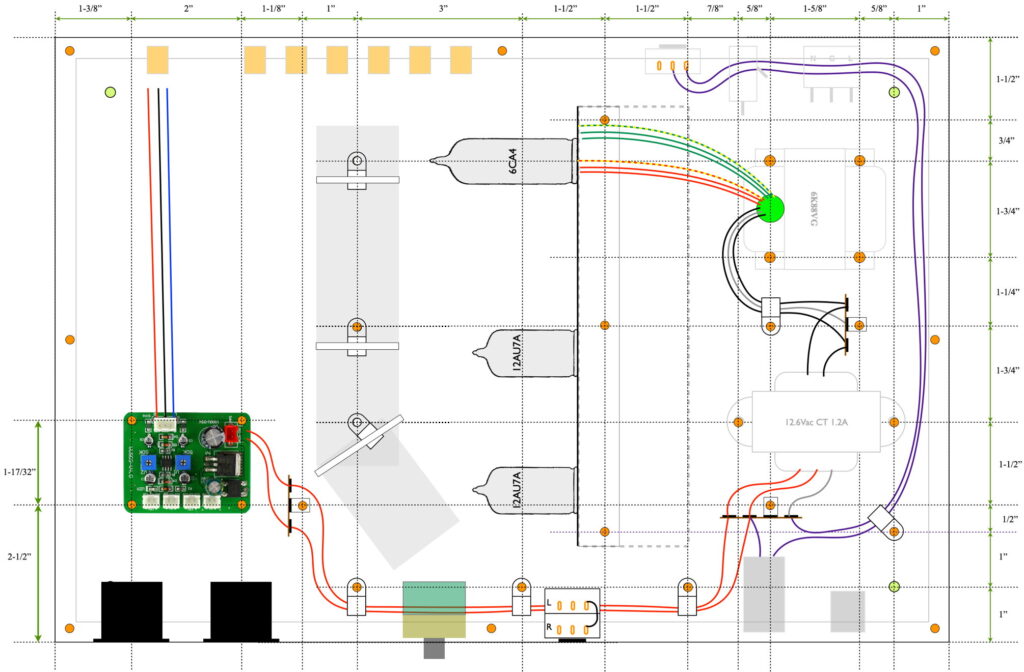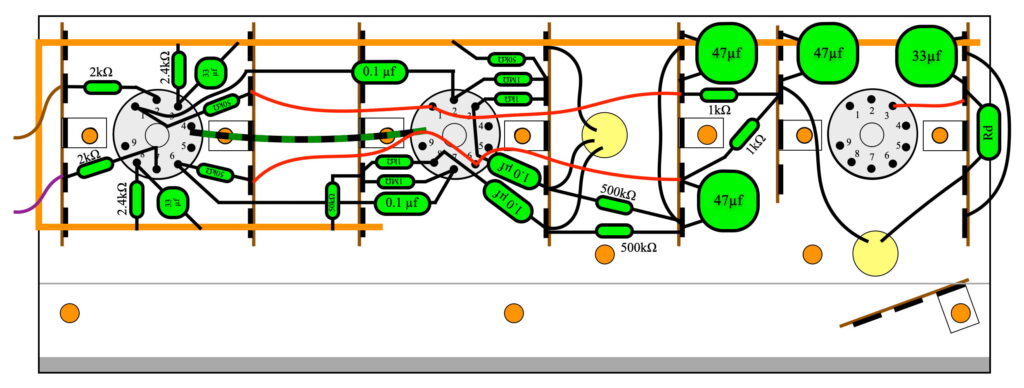Over the last several days I’ve made some progress on the layout of the new project. This is about the point where it’s time to start looking at wood.
The unit will have multiple inputs, an active “preamp” for adjusting gain levels, and meters for monitoring output levels. All of this needs to fit inside the unit. I decided that the tubes will be mounted horizontally on a vertical plate This makes the layout a little simpler. Here is my first attempt at the internal layout. I think I’m fairly happy with this so far.
This layout doesn’t include all the wiring, but it does show where all the major components should reside. Power transformers and circuits are all on the right, the active electronics are mounted on the vertical plate directly behind volume control, and the signal wiring and meters are on the left. With appropriate lead dress, I believe that this can be made very quiet. I may also include tube shields in this build. Just to minimize any interaction between the tubes and the signal lines running right by them (that’s the gray region to the left of the tubes).
The active electronics should be fairly straight forward. It is a simple gain stage and buffer. The design is for a total of ≈20dB of end to end gain. This means that the gain control should behave exactly as it does on the 12AU7 Color Preamp. The control will decrease signal level when set left of center and increase signal level when set right of center. Here is the schematic for the active electronics.
I have placed the volume control up front. This is for two reasons. First, this keeps the signal swing in the gain stages very small thus minimizing distortions. Second, it keeps the signal levels into the buffer stage small. This means that the drop in allowable buffer input voltage when the load impedance gets small doesn’t affect the performance (i.e. amps to which it’s connected may have input impedances as low as 10kΩ). I also split the power supplies so that there is lots of isolation between channels (≈62dB@120Hz + PSRR).
The vertical plate is eight inches long and three inches high. With the angle mounting bracket at the bottom this still leaves ample room for component placement. Here is the rough layout of the active electronics plate.
This view is from the right hand side showing the component side of the board. The input gain stages are on the left, the buffer stages are in the center, and the power supply is on the right. The 2H power choke is mounted on the tube side of the board near the bottom. Its leads come through the yellow hole below the rectifier socket.
The other yellow hole is a penetration for the output signal leads. However, now when thinking about it, I may route these line over the top or around the side. There is a risk of ground coupling if I leave it like this. I may need to think about this a little more.
This week I’ll probably select some wood for the chassis and get to work. I like to get the chassis glued up prior to cutting all the metal. This way, if the wood moves or does not come out exact, I can adjust when cutting the metal.
As always, questions and comments are welcome.




FYI, there’s a minor error in the 2nd sentence just below the component layout diagram. You have…
“The input gain stages are on the right, the buffer stages…”
The input stages are on the left.
Good catch. Corrected.
Hi Matt. Quick question: did you estimate current through the follower stage? I suppose I could figure it out, but I just noticed this design is a little different than the color preamp (which I built, but was forced to use MOSFETs for the “cathode follower” stage. Sorry for the affront…it’s a long story why.
The currents through the gain stages is 2.92mA per channel and through the cathode followers it is 3.71mA per channel. So about 6.6mA per channel for your power supply calculations. I realized that these numbers are recorded on the schematic in my notebook now. When I post the project I’ll update the schematic so all the information is there.
Nope. No affront at all. Your amp, your rules. It’s all good.
Good morning Matt:
I too have long been frustrated with all my inputs having various differing output intensities. Resulting in various differing settings on the volume control of the main amp.
I wish there was a single solution to this conundrum.
_________
I recently made a nice little RH84 type amp for a younger friend as a gift. I have it in the shop right now to complete testing. We had a funny conversation the other day, he asked why I had installed 3 inputs on it? I looked at him with a strange look on my face and said for the Phono, the CD player, and the radio, just like I made on all my other amps for myself. He looked at me rather sheepishly and said I do not have any of those, I just have my phone. How can I hook it up, does this have Blue tooth?
OOOOPS
So I am doing the research and found a Bluetooth receiver, I am waiting on a 5v power supply then I can test it out.
Some to consider in you design?
I hope this helps